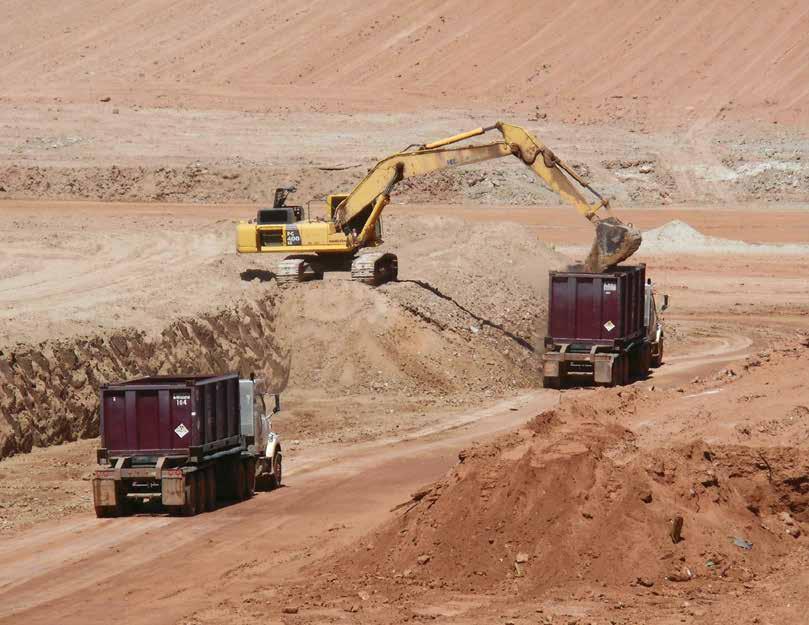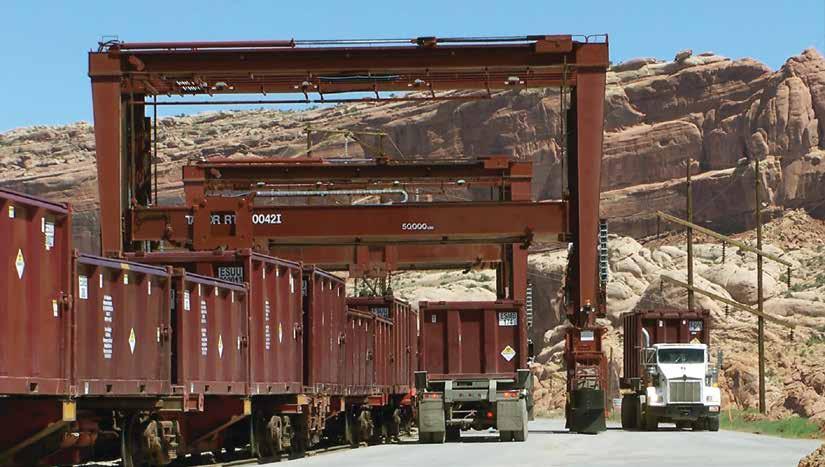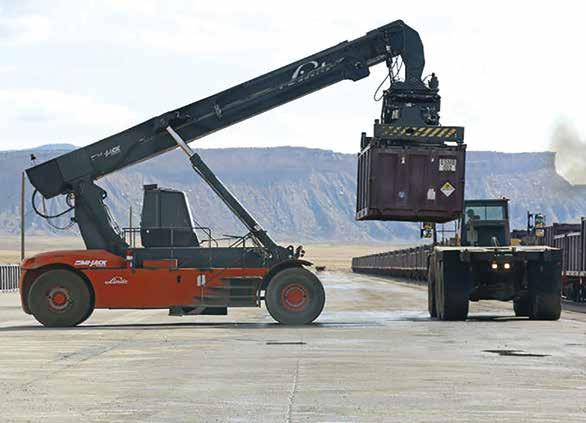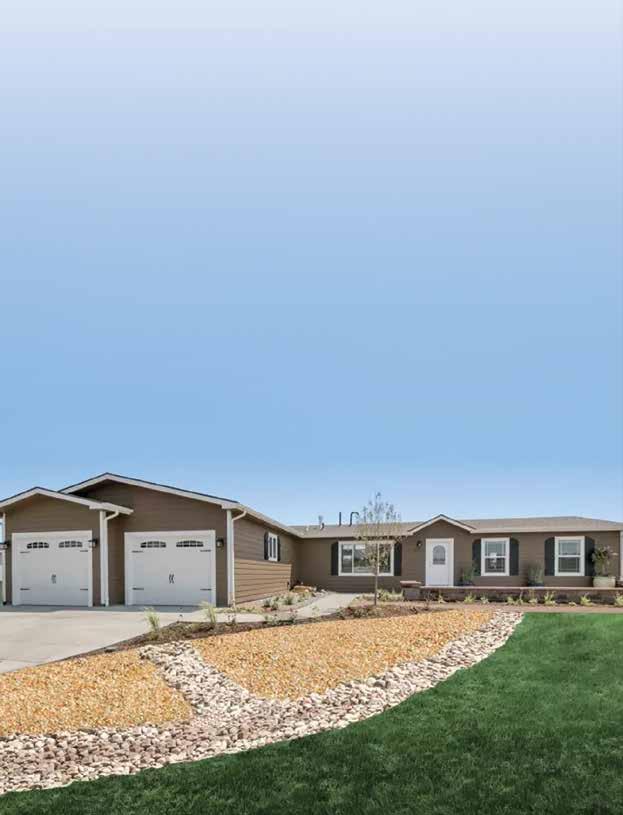
9 minute read
Uranium tailings project: 12 million tons and counting
12,000,000
TONS AND COUNTING
Spearheaded by locals, the federal cleanup of a massive pile of uranium era mine tailings pushes onward
Written by Sharon Sullivan
MARY MCGANN CHUCKLES WHEN SHE MENTIONS SERVING YELLOW CAKE DURING THE 2019 MILESTONE CELEBRATION MARKING THE REMOVAL OF 10 MILLION TONS OF URANIUM MILL TAILINGS FROM THE BANKS OF THE COLORADO RIVER.
MCGANN WAS OFFERING DESSERT TO FEDERAL OFFICIALS AND COMMUNITY MEMBERS – NOT THE RADIOACTIVE YELLOWCAKE THAT WAS PROCESSED FROM URANIUM ORE DECADES AGO AT THE FORMER URANIUM MILL PROCESSING SITE NEAR THE ENTRANCE TO ARCHES NATIONAL PARK. THE RESULTING WASTE - KNOWN LOCALLY AS THE “MOAB PILE” – COVERS 130 ACRES OF THE 489-ACRE SITE.
McGann, 69, has chaired Grand County’s Mill Tailings Project Steering Committee for the past six years. Years earlier, she and other local citizens took matters into their own hands to convince the Department of Energy (DOE) and U.S. Congress to remove the waste pile that was leaching toxic chemicals into the groundwater and river.
The Moab Uranium Mill Tailings Remedial Action Project (UMTRA) began in 2009 and, as of mid-October 2021, has moved 12 million, of the estimated 16 million tons of uranium tailings, to a permanent disposal site 32 miles north, in Crescent Junction. Security and maintenance take place at the former mill seven days a week, while tailings excavation and conditioning operations continue four days per week. In August 2021, 73,923 tons of tailings and mill debris were loaded onto trains and brought to Crescent Junction.
Moab became known as the “Uranium Capital of the World” after an impoverished geologist named Charlie Steen discovered a large, highgrade uranium deposit in 1952 – transforming a small Mormon farming and ranching community settled in 1855, into a booming mining town. Moab’s population doubled, then tripled as miners and their families came to Utah from across the country to stake their own claims.
The Atomic Energy Commission – the DOE’s predecessor – fueled the rush to mine the ore for its nuclear weapons program. The government incentivized uranium mining during that era by offering a high price and cash bonuses.
Steen had discovered an ore bed worth $60 million and, in 1955, built an $8 million processing mill called Uranium Reduction Company, which began operating in 1956 near Moab at a site next to the Colorado River. In 1962, the “King of Uranium” sold the processing mill to Atlas Minerals Corporation, which continued to process uranium ore for weapons through 1970, and for nuclear power plants after that date.
Separating uranium from the ore creates a sand-like waste material containing heavy metals and radium – a by-product of uranium’s decay. Radium releases radon, which creates radioactive particulates. These particles, when inhaled or ingested, increase a person’s risk of cancer.
Over the years the Moab pile grew to a mound 80-feet tall across dozens of acres. Atlas Minerals Corporation shut down operations in 1984, and declared bankruptcy in 1998.

Opposite page: An aerial photo of the 130-acre,16-million-ton uranium tailings pile, taken before work began to relocate the material from the banks of the Colorado River to a secure site near Crescent Junction. [Photo courtesy of Tom Till] This page: One scoop at a time, heavy equipment moves the massive pile, loading the tailings into containers that will be closed and loaded onto the train.
LOCALS GO TO WASHINGTON, D.C.
McGann’s predecessor, Joette Langianese, served on Grand County Council from 2001 to 2008, where she focused on getting the pile removed. She and other local leaders traveled on multiple occasions to Washington, D.C. to testify before Congress and meet with various U.S. Senators and Representatives to persuade the DOE to authorize cleanup of the site, and for Congress to fund the project.
The project has removed more than 925,000 pounds of ammonia and 5,000 pounds of uranium from the groundwater since 2003.
“We realized it would be hard for a small community (to make their voices heard) so we worked with the powerful Metropolitan Water District of Southern California (MWDSC),” says Langianese, 64.
Downstream users were concerned that a catastrophic event could unleash tons of toxic waste into the river, destroying its water supply. Metropolitan Water District lobbyists helped Langianese schedule meetings with key representatives from Arizona, Nevada, California and Utah – states that depend on the Colorado River for irrigation and drinking water. Utah Senators Orin Hatch and the late Bob Bennett, who chaired the appropriations committee, were particularly helpful, as were the California delegation, she says.
Tailings removal is important to Native American communities, too, says Lee Shenton, former UMTRA liaison from 2000-2018. A coalition of tribal communities, concerned about the water quality of the Colorado River, visited Moab to learn about the project. “It’s important to a lot of people, locally and (those) downstream,” Shenton says.
Fortunately, for Moab residents, the city’s own drinking water is sourced from groundwater in the La Sal Mountains and is among the most pristine water in the United States, says John Weisheit, who, along with Owen Lammers, co-founded the nonprofit Living Rivers/Colorado Riverkeeper in January 2000. That organization also lobbied the science community to remove the Moab pile, says Weisheit, 67.
“We felt it was imperative to be part of the campaign to get it off the flood plain,” he says. “We know the Colorado River has huge floods – three or four have occurred in the 19th century.” Three floods, of more than 300,000 cubic feet per second, have occurred within the past 2,000 years. In 1957, the year the mill was being built, the river overflowed up onto the construction site.
Two flooding incidents have occurred since the decision to move the pile, Langianese adds. One happened in 2007 when a thunderstorm erupted directly over the pile, dumping more than 4 inches in an hour. The deluge compromised the pile, inundated the site with flood waters, exposing the tailings and washing them into the river.
The second flooding occurred in 2011, during a high-water year when the Colorado River was running at 49,000 cubic-feet per second and had reached the toe of the pile, again washing tailings into the river. Fortunately, it was a cool spring that year – if temperatures had risen quickly, the flood could have been much worse, causing catastrophic damage, Langianese says.
MOVING THE PILE
Once the federal government approved removal of the pile, the steering committee began working on finding funding to implement the project.
“We were looking at a billion dollars,” Langianese says. “We continued our lobbying efforts to fund it.” The steering committee submitted comments to the DOE about the possibility of rockslides, flash floods, and other disaster-causing scenarios. It took approximately five years to secure approval to do the remediation, then another four years to find money to pay for it, she says.
The Department of Environmental Quality told the group they didn’t want the pile to be open for 50 years while being moved – it needed to happen fast.
The Obama administration provided TARP (Trouble Asset Relief Program) monies from the American Recovery and Reinvestment Act of 2009. When that funding was cut in 2012, and then again in 2017, employees were laid off and trains hauling the waste to Crescent Junction were reduced from two to four each day to one. The search for additional funding resumed.
McGann knew of Langianese’s experience working with Congress, and so she asked the former county councilor to return to the Mill Tailings Steering Committee as a community-at-large member. From 2017-2020, she, McGann, and city counselor Rani Derasary, and, in 2018, Tawny Knuteson-Boyd, traveled to Washington to lobby for project funding. They were promised $48 million, with an annual increase for inflation.
As Grand County’s first-ever UMTRA liaison, Shenton’s job was to ensure the community had accurate information regarding the project. The 75-year-old Shenton, who retired in 2018, (Jessica Thacker is current the UMTRA liaison) had previously worked on a U.S. military project helping to develop techniques for detecting contamination at a Baltimore-area arsenal where there was radioactive contamination.
Shenton helped community members understand what was going on at the site,

Top: Once featured on a postcard, the Uranium Reduction Corporation mill began processing ore on October 1, 1956. [Image courtesy Moab Museum] Bottom: A powerful gantry crane is used to lift containers full of contaminated material from trucks, and place them on a train that delivers the load



and clarified, when necessary, what he considered misleading information from the DOE. “I was not constrained by DOE public relations guidance,” Shenton says. “I had an obligation to my employer (Grand County) and the community to explain what was going on – although I did consult with the DOE.”
When Utah Rep. John Curtis came to Moab, Shenton gave him a guided two-hour tour of the site.
The steering committee demonstrated that locals have oversight over what the feds are doing regarding the Moab pile, says Langianese. “The county was really proactive; we didn’t just sit back and let the feds in without our say. We have a good partnership with the DOE.”
Though the steering committee is hopeful the tailings will be completely gone within the next five years, there will be other contaminated debris to remove from the site. The DOE assumed ownership of the property in 2001, and will continue to monitor the site for 50-60 years.
FUTURE PLANS FOR THE SITE
Meanwhile, the Mill Tailings Project Site Futures Committee, made up of Grand County citizens, has been developing plans on what to do with the riverfront property once remediation is complete. Ideas have included planting cottonwoods, willows and other native vegetation, as well as possibly adding a park, and a bike trail.
“I’ve been asking our congressmen and senators to deed the land back to Grand County to use as an asset for our citizens,” McGann says. The group has been working with Utah Senators Mike Lee, and Mitt Romney, and Rep. Curtis for help in acquiring the property for Grand County, along with money to make improvements at the site.
For more information about the project visit www.grandcountyutah.net/206/Moab-Tailings-Project-Site-Futures-Commi. n


Top: A reach stacker lifts a container of uranium mill tailings from the
Affordable Builders
Your Factory Built Home Specialists Modular IRC Duplex, Multi-family and ADU units Manufactured single and double wides • Park Models 121 East 100 South Ste.105, Moab By appointment 303-420-2672
www.affordable-builders.com affordablebuilders.gj@gmail.com
Ahh Moab!

Nancy Fitzgerald
Realtor 435.260.7327
nancyfitzmoab@gmail.com

Kevin Fitzgerald
Realtor 435.260.9890
kevinfitzmoab@gmail.com






